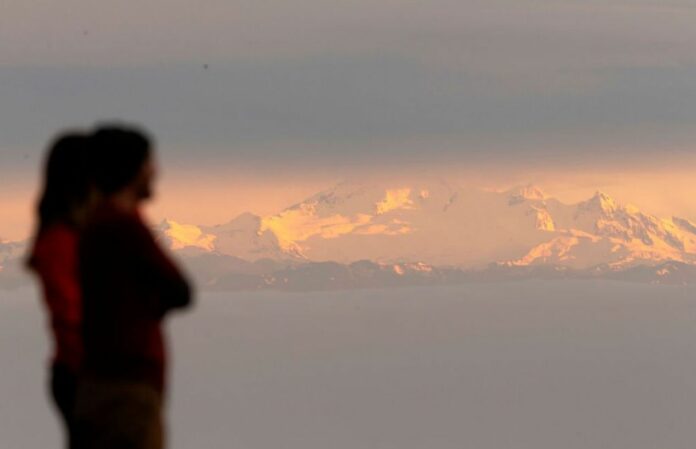A new study from the University of Colorado Boulder found that snow is melting earlier and more rain is falling instead of snow in the mountain ranges of the Western U.S. and Canada. This is leading to a thinner snowpack, which could affect farming, the risk of wildfires, and water supplies for cities in the summer.
The research, which was published in Nature Communications Earth & Environment, details changes in snowpack water storage across a 60-year period in Western North America. It found that between 1950 and 2013, the amount of water stored in the snowpack has dropped by a lot in more than 25% of the Mountain West. This is partly because more snow is melting in the winter and spring, which is breaking down the seasonal border.
“On average and in every mountainous region that we looked at, snow melt is occurring closer in time to when it fell,” adds lead author Kate Hale. “The timing of water availability is shifting toward earlier in the springtime, with less snow melt and water availability later in the summertime, suggesting that there will be water scarcity later in the year.”
The Importance of Timing in Water Supply: A Critical Factor for the Western U.S. and Canada
Snow plays a vital role in providing water for the Western United States and Canada. The majestic Rocky Mountains, Sierra Nevadas, and other mountain ranges have historically acted as natural water reservoirs for the region. Throughout the winter, they store snow, which gradually melts and becomes accessible as water during the crucial spring and summer months when demand is at its peak.
In order to predict and manage water resources effectively, state and regional water managers rely on a significant indicator known as snow water equivalent (SWE). This metric measures the amount of water that will be generated when a given volume of snow melts. As Dr. Hale, a postdoctoral researcher at the University of Vermont, explains, these managers analyze SWE data every year on April 1st.
However, it’s essential to recognize that this April 1st assessment only captures a single moment in time. It fails to provide crucial insights into the accumulation pattern of snow over the preceding six months. It doesn’t reveal whether the snowfall occurred gradually over time, if it all arrived in a massive deluge on March 31st, or if it was already in the process of melting.
“From a hydrologic perspective, the only thing that’s unique about snow is that it delays the timing of water input to watersheds. And just looking at a snapshot of snow water equivalent doesn’t give you a sense as to how long that snow water equivalent has been on the ground,” adds Noah Molotch.
Hale utilized two publicly accessible data sources to create a novel metric called the Snow Storage Index (SSI). This index takes into account the quantity and timing of snowfall, as well as the process of snowmelt before and after April 1. Unlike the Snow Water Equivalent (SWE) which captures a single moment in time, Hale’s SSI provides a more comprehensive representation, akin to a metaphorical video. It condenses the duration between the occurrence of rainfall or snowfall during the winter season and the subsequent availability of surface water within a specific area into a single numerical value.
“The snow storage index allows us to look at snow water storage, not just in the context of how much is there at any given time, but the duration of that storage on the ground,” points out Molotch.
This enabled the scientists to assess the effectiveness of various mountainous regions in the Western region as water sources over the last six decades. Their analysis revealed a consistent decline in performance across all these areas.
Water Management for the Present and Future
A substantial Snowmelt Seasonality Index (SSI), with values approaching 1.0, was identified in areas characterized by highly seasonal snowfall. Take the Cascades, for instance, where snow accumulates during the fall and winter seasons, remaining stored for approximately six months before gradually melting throughout the spring and summer. In the Rocky Mountains of Colorado, however, the SSI ranges between 0 and 0.5, indicating a combination of snow accumulation and melting during the colder half of the year.
Fortunately, the Rockies and the Front Range have adapted to this cyclical pattern of snowfall and snowmelt during winter and spring, making it easier for the region to adjust to decreased snowpack water storage resulting from global warming. Conversely, mountainous areas near the West Coast, heavily reliant on spring and summer meltwater from snowpack, may face significant challenges as the water melts earlier in the year, leaving them with limited availability come late summer.
Half a century ago, the Western United States witnessed the construction of numerous dams, providing abundant water access for urban centers and agriculture. However, with the gradual disappearance of these “water towers” due to melting, the reservoirs they once filled are also at risk.
By recognizing the potential impacts of climate change on water resources, it is crucial for water management practices to evolve. Through comprehensive planning, scientists, policymakers, and resource managers can work collaboratively to develop strategies that ensure sustainable water usage and address the challenges posed by diminishing snowpack and altered hydrological patterns.
“The snowpack is eroding and disappearing before our eyes. That’s going to present challenges in terms of managing the infrastructure that’s allowed the Western United States to flourish over the last 100 years,” adds Molotch.
Source: 10.1038/s43247-023-00751-3
Image Credit: Andrew Chin/Getty Images
